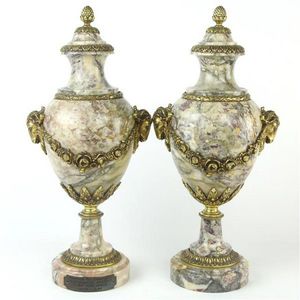Georgian cut crystal set with decanters and rummers
You must be a subscriber, and be logged in to view price and dealer details.
Subscribe Now to view actual auction price for this item
When you subscribe, you have the option of setting the currency in which to display prices to $Au, $US, $NZ or Stg.
- Georgian - As an English stylistic period, Georgian is usually taken to cover the period from George I (1714) to the Regency of Prince George (1811-20), although the period from 1800 to 1830 is sometimes designated as the Regency period. During the Georgian period the great English cabinetmakers and designers such as Chippendale, Hepplewhite, Adam Sheraton etc., were all active.
Therefore there isn't a single 'Georgian style' as such and to say something is 'Georgian', usually means it was made between 1714 and 1830. This assumes we discount George V and George VI, both being from the 20th century.
The styles popular at the time of each reign were:
George I (1714-1727) saw out the last years of the Baroque period.
George II (1727-1760) reigned during the Rococo period.
George III (1760-1820) saw the last gasp of the Rococo, all of the early Neo-Classic 'Adam style' and most of the later neo-Classic 'Regency style'.
George IV (Prince Regent 1820-1830)encompassed the last of the 'Regency' style.
William IV's reign (1830-1837) was something of a no man's land (stylistically) and he wasn't a 'George' anyway. He covered the last glimmerings of 'Regency' and the start of the 'Victorian' style. - Engraved Glass - The method of decorating glass by marking the surface with a sharp intrument such as a diamond, metal needle or rotating cutting wheel. As pressure is applied to the surface, best results for engraving are achieved if the glass is of sufficient thickness. In the 19th century etching was used to decorate some table glassware that was too fine to take an engraving tool.
This item has been included into following indexes:
Visually similar items

Austro-Hungarian silver 800 standard figural covered urn modelled with a figural finial of a miner in traditional attire, holding a pick, having scrolled, beaded & rope twist detail. Maker A.P.

John Stinton Jnr for Royal Worcester, porcelain double-handled vase, c. 1910, of campana form with scroll handles, painted with a herd of highland cattle grazing in a misty mountainous landscape, on square chamfered base, signed 'John Stinton', with printe

French marble & gilt bronze pair of urns having goat head handles, applied floral bunting, acorn finials & a plaque inscribed 'Hommage Reconnaissant Des Federations Apicoles À Me Verlinden 1890-1930'. Height 45 cm

A pair of French late 19th century porcelain vases converted to candelabra, polychrome decorated with Budgerigars, now converted to candelabra with Louis XVI style ormolu candle arms, 87 cm high, 35 cm diam
